CNMT220 Change Management: Strategies for Effective Implementation
VerifiedAdded on 2023/04/21
|15
|4416
|152
Essay
AI Summary
This essay provides a comprehensive overview of organisational development and change management, covering topics such as the definition and relevance of organisational development, trends impacting organisations, and the application of quantum change. It discusses Lewin's change management model, consultant styles, and strategies for managing resistance to change. Furthermore, the essay explores the importance of cultural differences in global communication, the role of change agents, and the characteristics of self-designing and learning organisations. Finally, it examines performance management models and the goal-setting method of Management By Objectives (MBO), highlighting key considerations for effective implementation. Desklib provides more solved assignments for students.
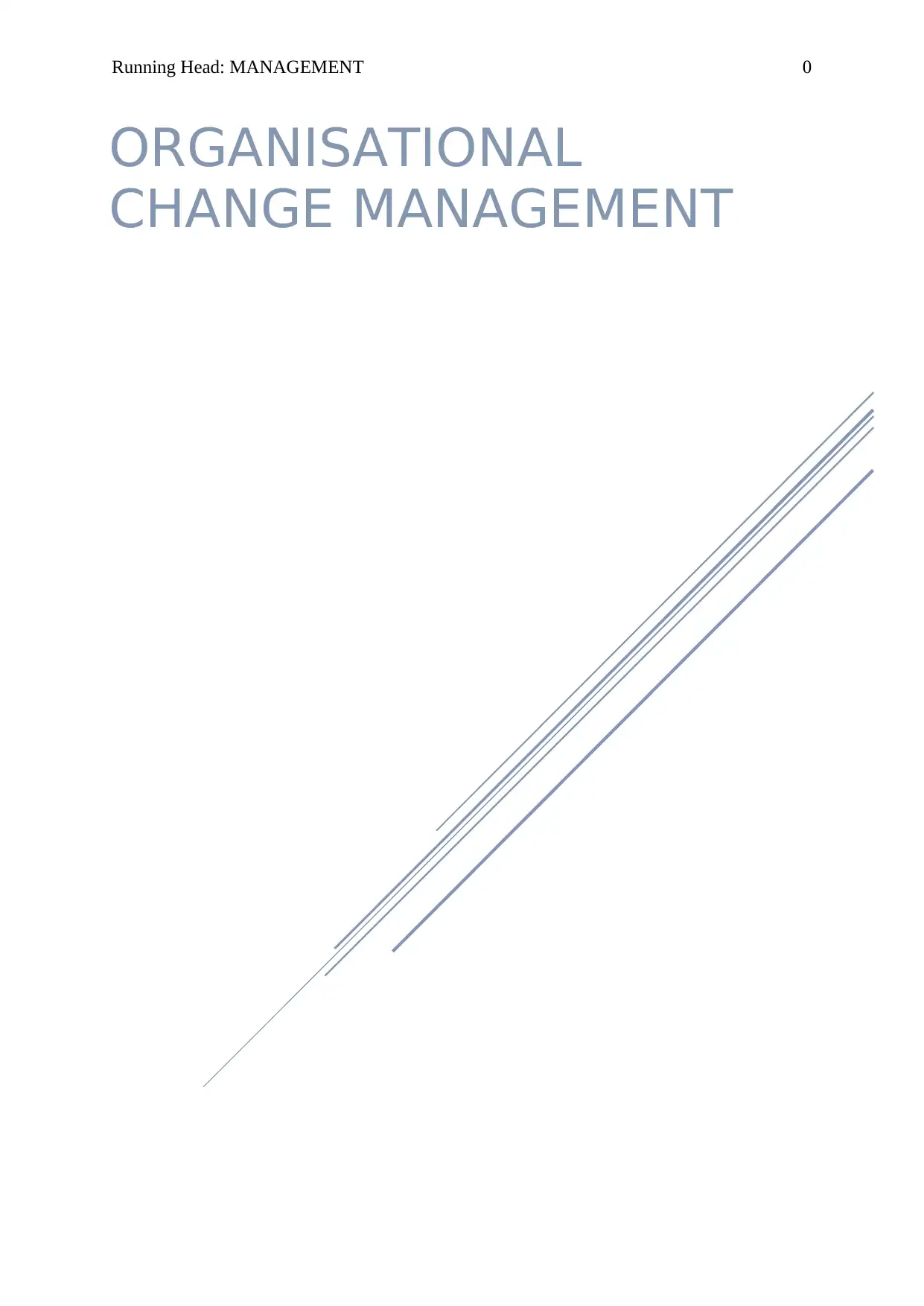
Running Head: MANAGEMENT 0
ORGANISATIONAL
CHANGE MANAGEMENT
ORGANISATIONAL
CHANGE MANAGEMENT
Paraphrase This Document
Need a fresh take? Get an instant paraphrase of this document with our AI Paraphraser
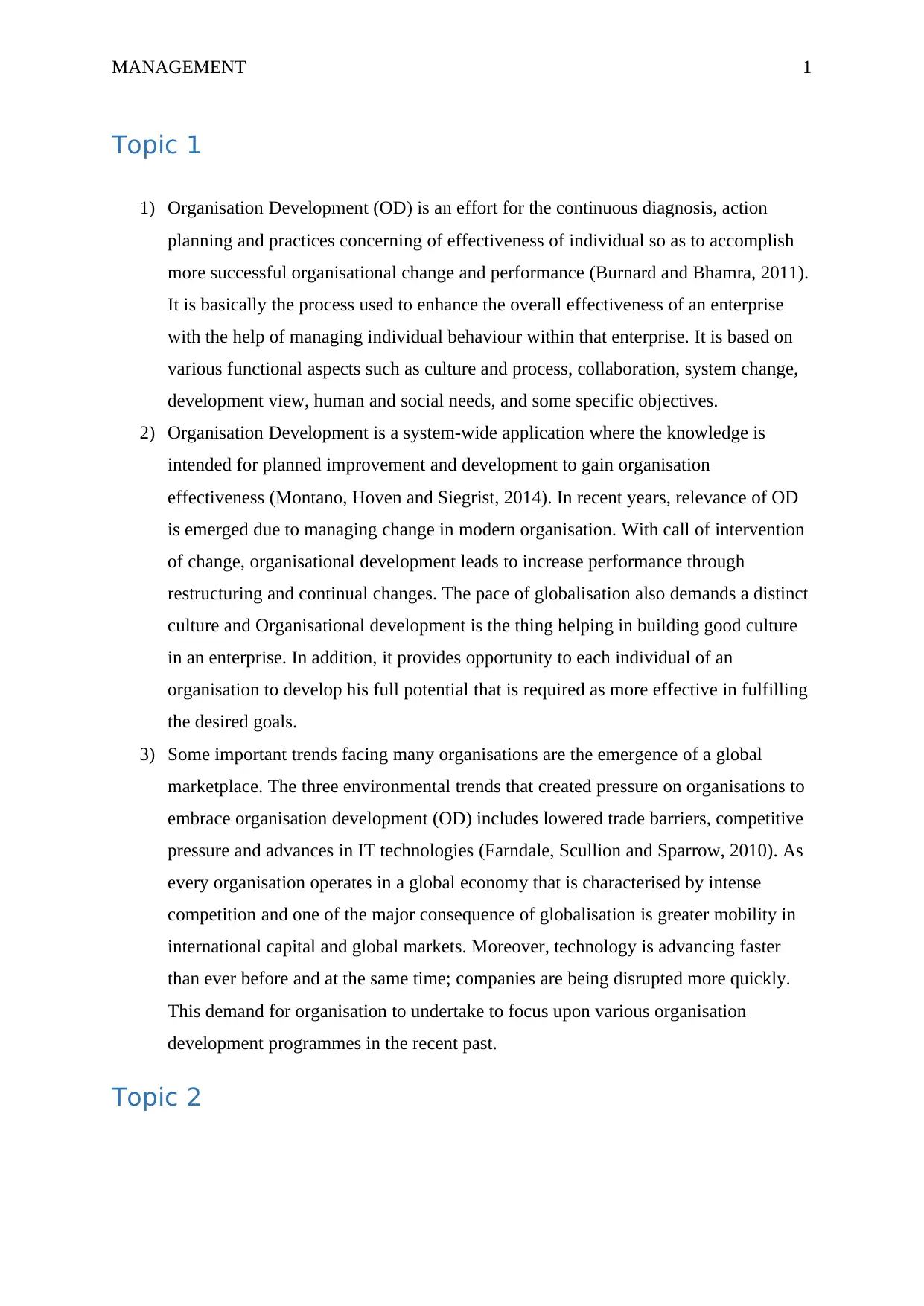
MANAGEMENT 1
Topic 1
1) Organisation Development (OD) is an effort for the continuous diagnosis, action
planning and practices concerning of effectiveness of individual so as to accomplish
more successful organisational change and performance (Burnard and Bhamra, 2011).
It is basically the process used to enhance the overall effectiveness of an enterprise
with the help of managing individual behaviour within that enterprise. It is based on
various functional aspects such as culture and process, collaboration, system change,
development view, human and social needs, and some specific objectives.
2) Organisation Development is a system-wide application where the knowledge is
intended for planned improvement and development to gain organisation
effectiveness (Montano, Hoven and Siegrist, 2014). In recent years, relevance of OD
is emerged due to managing change in modern organisation. With call of intervention
of change, organisational development leads to increase performance through
restructuring and continual changes. The pace of globalisation also demands a distinct
culture and Organisational development is the thing helping in building good culture
in an enterprise. In addition, it provides opportunity to each individual of an
organisation to develop his full potential that is required as more effective in fulfilling
the desired goals.
3) Some important trends facing many organisations are the emergence of a global
marketplace. The three environmental trends that created pressure on organisations to
embrace organisation development (OD) includes lowered trade barriers, competitive
pressure and advances in IT technologies (Farndale, Scullion and Sparrow, 2010). As
every organisation operates in a global economy that is characterised by intense
competition and one of the major consequence of globalisation is greater mobility in
international capital and global markets. Moreover, technology is advancing faster
than ever before and at the same time; companies are being disrupted more quickly.
This demand for organisation to undertake to focus upon various organisation
development programmes in the recent past.
Topic 2
Topic 1
1) Organisation Development (OD) is an effort for the continuous diagnosis, action
planning and practices concerning of effectiveness of individual so as to accomplish
more successful organisational change and performance (Burnard and Bhamra, 2011).
It is basically the process used to enhance the overall effectiveness of an enterprise
with the help of managing individual behaviour within that enterprise. It is based on
various functional aspects such as culture and process, collaboration, system change,
development view, human and social needs, and some specific objectives.
2) Organisation Development is a system-wide application where the knowledge is
intended for planned improvement and development to gain organisation
effectiveness (Montano, Hoven and Siegrist, 2014). In recent years, relevance of OD
is emerged due to managing change in modern organisation. With call of intervention
of change, organisational development leads to increase performance through
restructuring and continual changes. The pace of globalisation also demands a distinct
culture and Organisational development is the thing helping in building good culture
in an enterprise. In addition, it provides opportunity to each individual of an
organisation to develop his full potential that is required as more effective in fulfilling
the desired goals.
3) Some important trends facing many organisations are the emergence of a global
marketplace. The three environmental trends that created pressure on organisations to
embrace organisation development (OD) includes lowered trade barriers, competitive
pressure and advances in IT technologies (Farndale, Scullion and Sparrow, 2010). As
every organisation operates in a global economy that is characterised by intense
competition and one of the major consequence of globalisation is greater mobility in
international capital and global markets. Moreover, technology is advancing faster
than ever before and at the same time; companies are being disrupted more quickly.
This demand for organisation to undertake to focus upon various organisation
development programmes in the recent past.
Topic 2
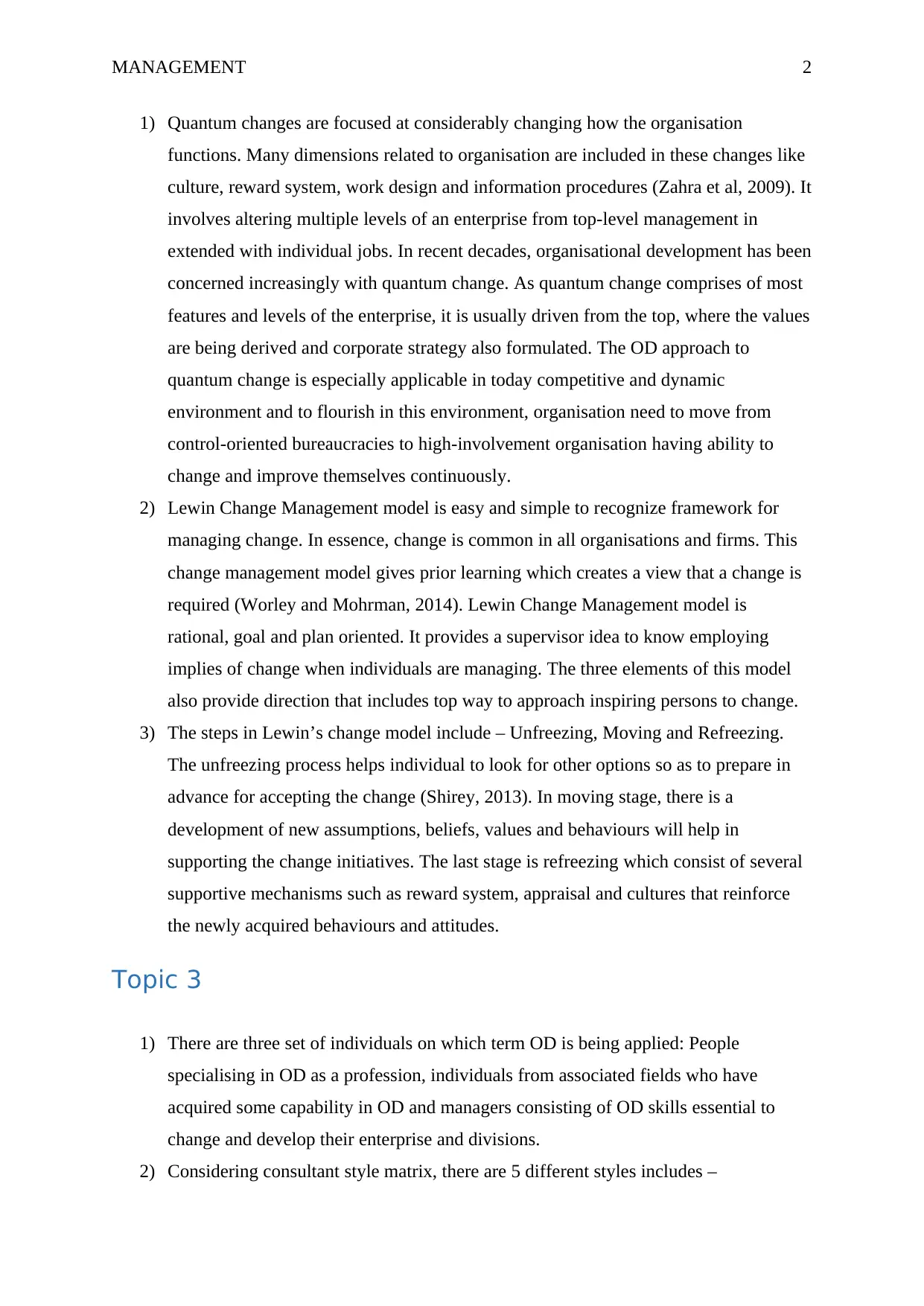
MANAGEMENT 2
1) Quantum changes are focused at considerably changing how the organisation
functions. Many dimensions related to organisation are included in these changes like
culture, reward system, work design and information procedures (Zahra et al, 2009). It
involves altering multiple levels of an enterprise from top-level management in
extended with individual jobs. In recent decades, organisational development has been
concerned increasingly with quantum change. As quantum change comprises of most
features and levels of the enterprise, it is usually driven from the top, where the values
are being derived and corporate strategy also formulated. The OD approach to
quantum change is especially applicable in today competitive and dynamic
environment and to flourish in this environment, organisation need to move from
control-oriented bureaucracies to high-involvement organisation having ability to
change and improve themselves continuously.
2) Lewin Change Management model is easy and simple to recognize framework for
managing change. In essence, change is common in all organisations and firms. This
change management model gives prior learning which creates a view that a change is
required (Worley and Mohrman, 2014). Lewin Change Management model is
rational, goal and plan oriented. It provides a supervisor idea to know employing
implies of change when individuals are managing. The three elements of this model
also provide direction that includes top way to approach inspiring persons to change.
3) The steps in Lewin’s change model include – Unfreezing, Moving and Refreezing.
The unfreezing process helps individual to look for other options so as to prepare in
advance for accepting the change (Shirey, 2013). In moving stage, there is a
development of new assumptions, beliefs, values and behaviours will help in
supporting the change initiatives. The last stage is refreezing which consist of several
supportive mechanisms such as reward system, appraisal and cultures that reinforce
the newly acquired behaviours and attitudes.
Topic 3
1) There are three set of individuals on which term OD is being applied: People
specialising in OD as a profession, individuals from associated fields who have
acquired some capability in OD and managers consisting of OD skills essential to
change and develop their enterprise and divisions.
2) Considering consultant style matrix, there are 5 different styles includes –
1) Quantum changes are focused at considerably changing how the organisation
functions. Many dimensions related to organisation are included in these changes like
culture, reward system, work design and information procedures (Zahra et al, 2009). It
involves altering multiple levels of an enterprise from top-level management in
extended with individual jobs. In recent decades, organisational development has been
concerned increasingly with quantum change. As quantum change comprises of most
features and levels of the enterprise, it is usually driven from the top, where the values
are being derived and corporate strategy also formulated. The OD approach to
quantum change is especially applicable in today competitive and dynamic
environment and to flourish in this environment, organisation need to move from
control-oriented bureaucracies to high-involvement organisation having ability to
change and improve themselves continuously.
2) Lewin Change Management model is easy and simple to recognize framework for
managing change. In essence, change is common in all organisations and firms. This
change management model gives prior learning which creates a view that a change is
required (Worley and Mohrman, 2014). Lewin Change Management model is
rational, goal and plan oriented. It provides a supervisor idea to know employing
implies of change when individuals are managing. The three elements of this model
also provide direction that includes top way to approach inspiring persons to change.
3) The steps in Lewin’s change model include – Unfreezing, Moving and Refreezing.
The unfreezing process helps individual to look for other options so as to prepare in
advance for accepting the change (Shirey, 2013). In moving stage, there is a
development of new assumptions, beliefs, values and behaviours will help in
supporting the change initiatives. The last stage is refreezing which consist of several
supportive mechanisms such as reward system, appraisal and cultures that reinforce
the newly acquired behaviours and attitudes.
Topic 3
1) There are three set of individuals on which term OD is being applied: People
specialising in OD as a profession, individuals from associated fields who have
acquired some capability in OD and managers consisting of OD skills essential to
change and develop their enterprise and divisions.
2) Considering consultant style matrix, there are 5 different styles includes –
⊘ This is a preview!⊘
Do you want full access?
Subscribe today to unlock all pages.

Trusted by 1+ million students worldwide
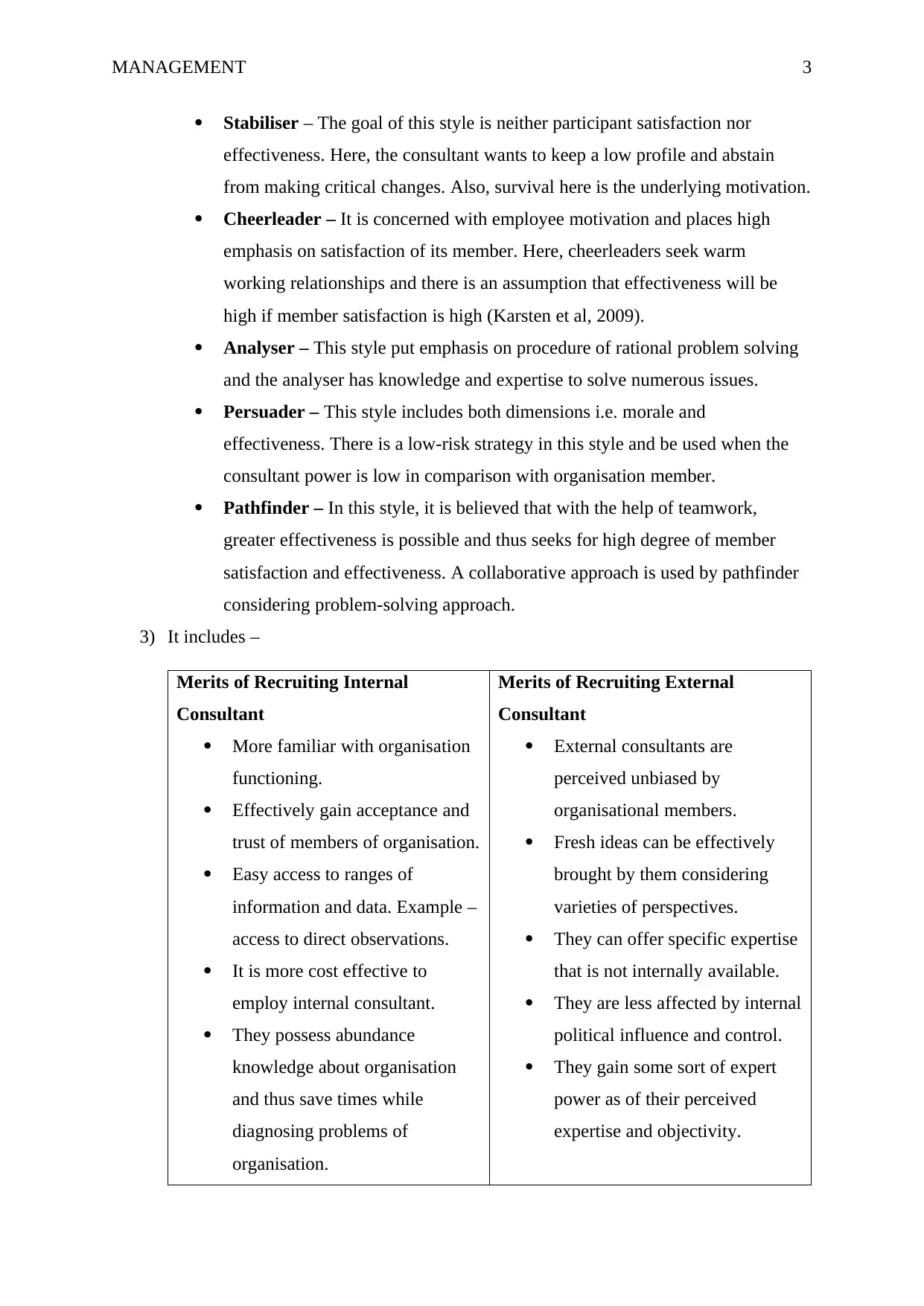
MANAGEMENT 3
Stabiliser – The goal of this style is neither participant satisfaction nor
effectiveness. Here, the consultant wants to keep a low profile and abstain
from making critical changes. Also, survival here is the underlying motivation.
Cheerleader – It is concerned with employee motivation and places high
emphasis on satisfaction of its member. Here, cheerleaders seek warm
working relationships and there is an assumption that effectiveness will be
high if member satisfaction is high (Karsten et al, 2009).
Analyser – This style put emphasis on procedure of rational problem solving
and the analyser has knowledge and expertise to solve numerous issues.
Persuader – This style includes both dimensions i.e. morale and
effectiveness. There is a low-risk strategy in this style and be used when the
consultant power is low in comparison with organisation member.
Pathfinder – In this style, it is believed that with the help of teamwork,
greater effectiveness is possible and thus seeks for high degree of member
satisfaction and effectiveness. A collaborative approach is used by pathfinder
considering problem-solving approach.
3) It includes –
Merits of Recruiting Internal
Consultant
More familiar with organisation
functioning.
Effectively gain acceptance and
trust of members of organisation.
Easy access to ranges of
information and data. Example –
access to direct observations.
It is more cost effective to
employ internal consultant.
They possess abundance
knowledge about organisation
and thus save times while
diagnosing problems of
organisation.
Merits of Recruiting External
Consultant
External consultants are
perceived unbiased by
organisational members.
Fresh ideas can be effectively
brought by them considering
varieties of perspectives.
They can offer specific expertise
that is not internally available.
They are less affected by internal
political influence and control.
They gain some sort of expert
power as of their perceived
expertise and objectivity.
Stabiliser – The goal of this style is neither participant satisfaction nor
effectiveness. Here, the consultant wants to keep a low profile and abstain
from making critical changes. Also, survival here is the underlying motivation.
Cheerleader – It is concerned with employee motivation and places high
emphasis on satisfaction of its member. Here, cheerleaders seek warm
working relationships and there is an assumption that effectiveness will be
high if member satisfaction is high (Karsten et al, 2009).
Analyser – This style put emphasis on procedure of rational problem solving
and the analyser has knowledge and expertise to solve numerous issues.
Persuader – This style includes both dimensions i.e. morale and
effectiveness. There is a low-risk strategy in this style and be used when the
consultant power is low in comparison with organisation member.
Pathfinder – In this style, it is believed that with the help of teamwork,
greater effectiveness is possible and thus seeks for high degree of member
satisfaction and effectiveness. A collaborative approach is used by pathfinder
considering problem-solving approach.
3) It includes –
Merits of Recruiting Internal
Consultant
More familiar with organisation
functioning.
Effectively gain acceptance and
trust of members of organisation.
Easy access to ranges of
information and data. Example –
access to direct observations.
It is more cost effective to
employ internal consultant.
They possess abundance
knowledge about organisation
and thus save times while
diagnosing problems of
organisation.
Merits of Recruiting External
Consultant
External consultants are
perceived unbiased by
organisational members.
Fresh ideas can be effectively
brought by them considering
varieties of perspectives.
They can offer specific expertise
that is not internally available.
They are less affected by internal
political influence and control.
They gain some sort of expert
power as of their perceived
expertise and objectivity.
Paraphrase This Document
Need a fresh take? Get an instant paraphrase of this document with our AI Paraphraser
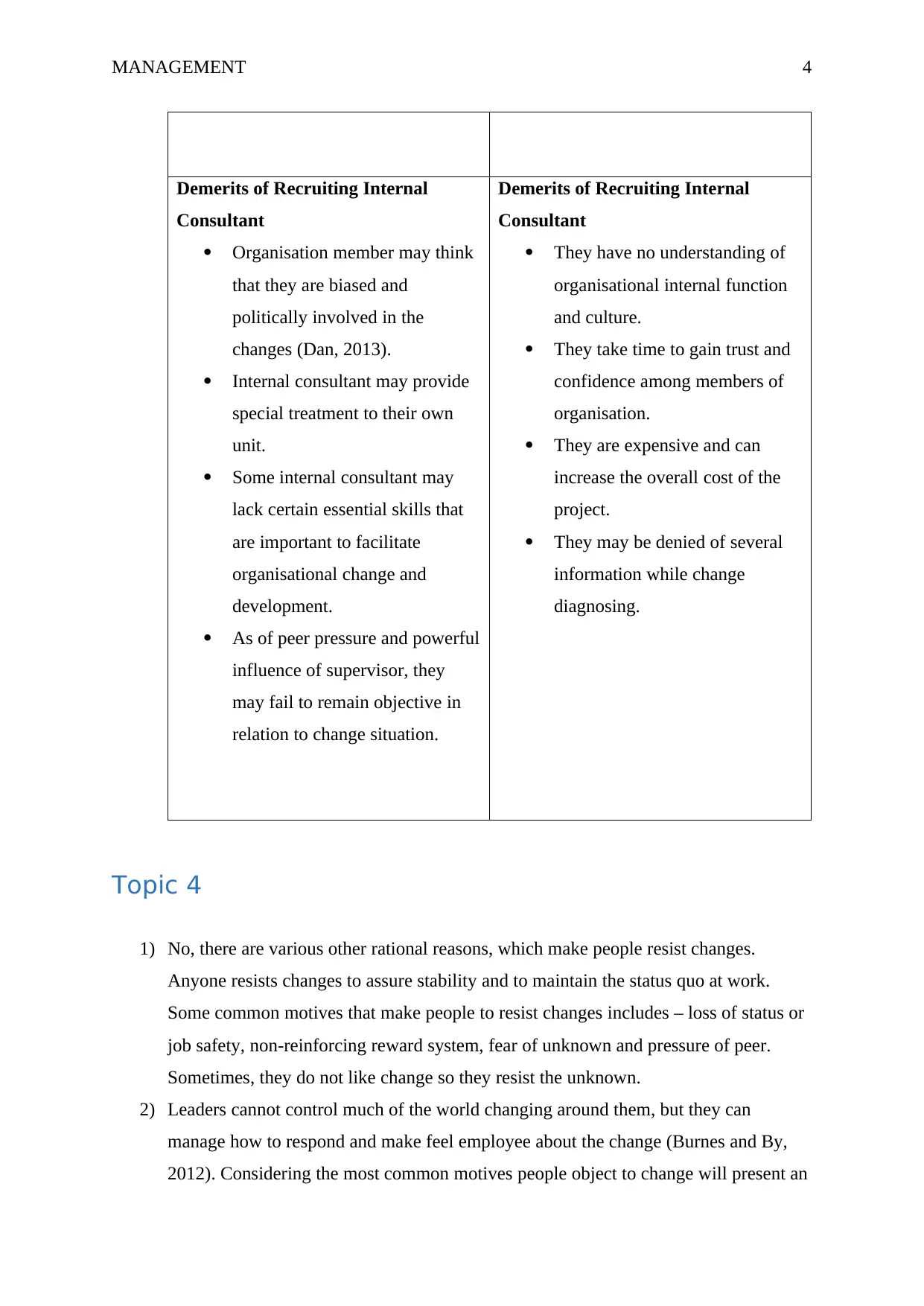
MANAGEMENT 4
Demerits of Recruiting Internal
Consultant
Organisation member may think
that they are biased and
politically involved in the
changes (Dan, 2013).
Internal consultant may provide
special treatment to their own
unit.
Some internal consultant may
lack certain essential skills that
are important to facilitate
organisational change and
development.
As of peer pressure and powerful
influence of supervisor, they
may fail to remain objective in
relation to change situation.
Demerits of Recruiting Internal
Consultant
They have no understanding of
organisational internal function
and culture.
They take time to gain trust and
confidence among members of
organisation.
They are expensive and can
increase the overall cost of the
project.
They may be denied of several
information while change
diagnosing.
Topic 4
1) No, there are various other rational reasons, which make people resist changes.
Anyone resists changes to assure stability and to maintain the status quo at work.
Some common motives that make people to resist changes includes – loss of status or
job safety, non-reinforcing reward system, fear of unknown and pressure of peer.
Sometimes, they do not like change so they resist the unknown.
2) Leaders cannot control much of the world changing around them, but they can
manage how to respond and make feel employee about the change (Burnes and By,
2012). Considering the most common motives people object to change will present an
Demerits of Recruiting Internal
Consultant
Organisation member may think
that they are biased and
politically involved in the
changes (Dan, 2013).
Internal consultant may provide
special treatment to their own
unit.
Some internal consultant may
lack certain essential skills that
are important to facilitate
organisational change and
development.
As of peer pressure and powerful
influence of supervisor, they
may fail to remain objective in
relation to change situation.
Demerits of Recruiting Internal
Consultant
They have no understanding of
organisational internal function
and culture.
They take time to gain trust and
confidence among members of
organisation.
They are expensive and can
increase the overall cost of the
project.
They may be denied of several
information while change
diagnosing.
Topic 4
1) No, there are various other rational reasons, which make people resist changes.
Anyone resists changes to assure stability and to maintain the status quo at work.
Some common motives that make people to resist changes includes – loss of status or
job safety, non-reinforcing reward system, fear of unknown and pressure of peer.
Sometimes, they do not like change so they resist the unknown.
2) Leaders cannot control much of the world changing around them, but they can
manage how to respond and make feel employee about the change (Burnes and By,
2012). Considering the most common motives people object to change will present an
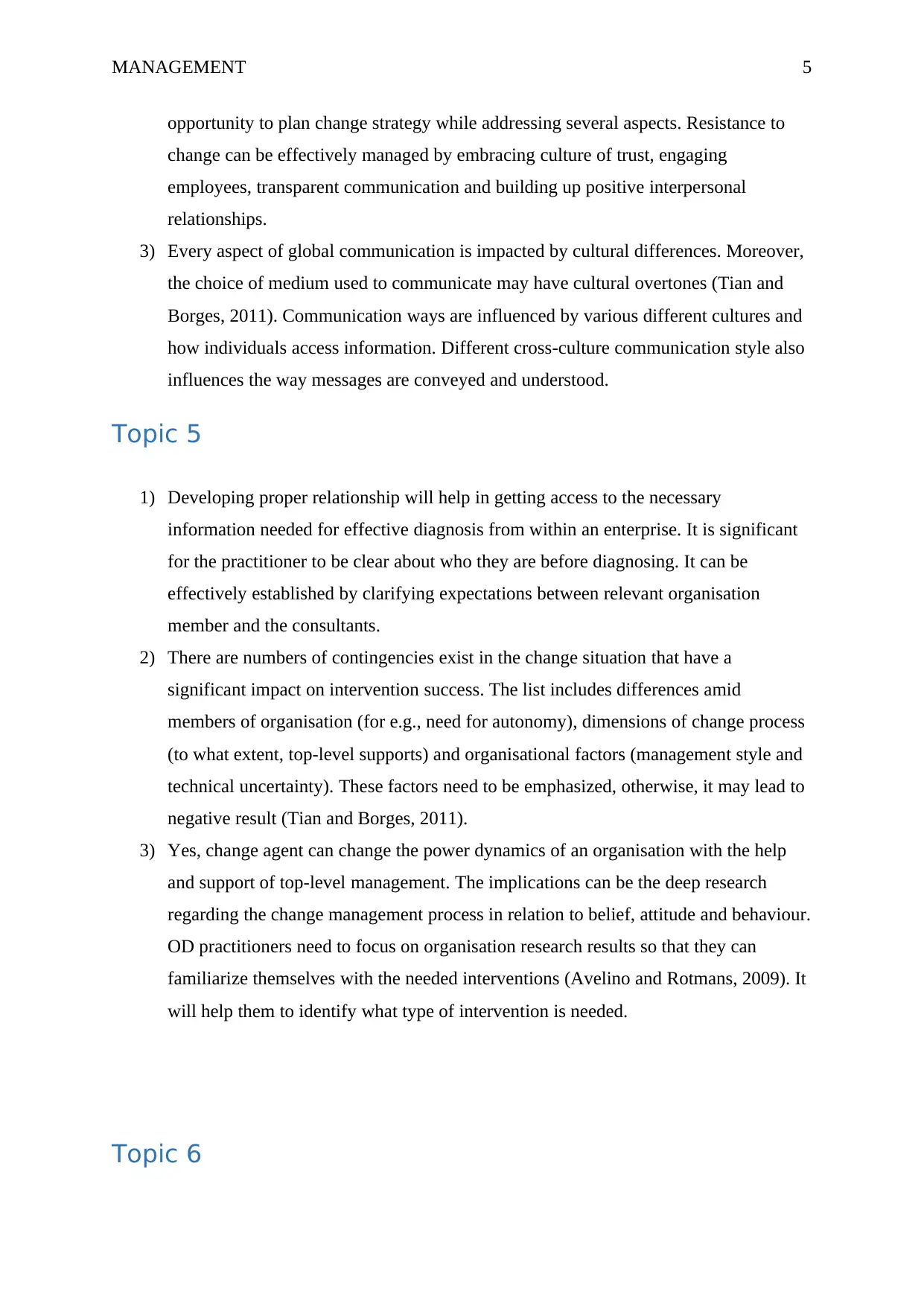
MANAGEMENT 5
opportunity to plan change strategy while addressing several aspects. Resistance to
change can be effectively managed by embracing culture of trust, engaging
employees, transparent communication and building up positive interpersonal
relationships.
3) Every aspect of global communication is impacted by cultural differences. Moreover,
the choice of medium used to communicate may have cultural overtones (Tian and
Borges, 2011). Communication ways are influenced by various different cultures and
how individuals access information. Different cross-culture communication style also
influences the way messages are conveyed and understood.
Topic 5
1) Developing proper relationship will help in getting access to the necessary
information needed for effective diagnosis from within an enterprise. It is significant
for the practitioner to be clear about who they are before diagnosing. It can be
effectively established by clarifying expectations between relevant organisation
member and the consultants.
2) There are numbers of contingencies exist in the change situation that have a
significant impact on intervention success. The list includes differences amid
members of organisation (for e.g., need for autonomy), dimensions of change process
(to what extent, top-level supports) and organisational factors (management style and
technical uncertainty). These factors need to be emphasized, otherwise, it may lead to
negative result (Tian and Borges, 2011).
3) Yes, change agent can change the power dynamics of an organisation with the help
and support of top-level management. The implications can be the deep research
regarding the change management process in relation to belief, attitude and behaviour.
OD practitioners need to focus on organisation research results so that they can
familiarize themselves with the needed interventions (Avelino and Rotmans, 2009). It
will help them to identify what type of intervention is needed.
Topic 6
opportunity to plan change strategy while addressing several aspects. Resistance to
change can be effectively managed by embracing culture of trust, engaging
employees, transparent communication and building up positive interpersonal
relationships.
3) Every aspect of global communication is impacted by cultural differences. Moreover,
the choice of medium used to communicate may have cultural overtones (Tian and
Borges, 2011). Communication ways are influenced by various different cultures and
how individuals access information. Different cross-culture communication style also
influences the way messages are conveyed and understood.
Topic 5
1) Developing proper relationship will help in getting access to the necessary
information needed for effective diagnosis from within an enterprise. It is significant
for the practitioner to be clear about who they are before diagnosing. It can be
effectively established by clarifying expectations between relevant organisation
member and the consultants.
2) There are numbers of contingencies exist in the change situation that have a
significant impact on intervention success. The list includes differences amid
members of organisation (for e.g., need for autonomy), dimensions of change process
(to what extent, top-level supports) and organisational factors (management style and
technical uncertainty). These factors need to be emphasized, otherwise, it may lead to
negative result (Tian and Borges, 2011).
3) Yes, change agent can change the power dynamics of an organisation with the help
and support of top-level management. The implications can be the deep research
regarding the change management process in relation to belief, attitude and behaviour.
OD practitioners need to focus on organisation research results so that they can
familiarize themselves with the needed interventions (Avelino and Rotmans, 2009). It
will help them to identify what type of intervention is needed.
Topic 6
⊘ This is a preview!⊘
Do you want full access?
Subscribe today to unlock all pages.

Trusted by 1+ million students worldwide
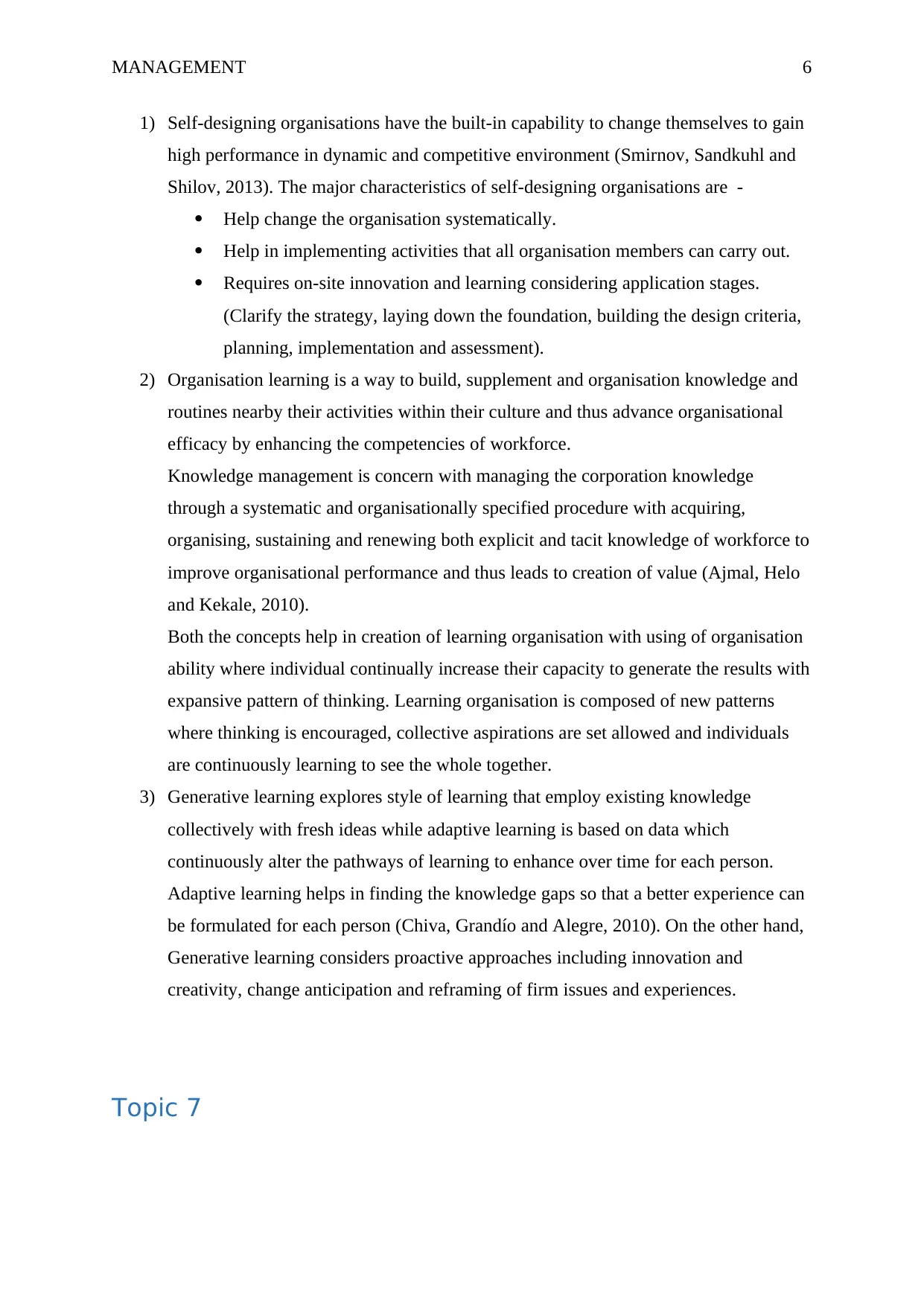
MANAGEMENT 6
1) Self-designing organisations have the built-in capability to change themselves to gain
high performance in dynamic and competitive environment (Smirnov, Sandkuhl and
Shilov, 2013). The major characteristics of self-designing organisations are -
Help change the organisation systematically.
Help in implementing activities that all organisation members can carry out.
Requires on-site innovation and learning considering application stages.
(Clarify the strategy, laying down the foundation, building the design criteria,
planning, implementation and assessment).
2) Organisation learning is a way to build, supplement and organisation knowledge and
routines nearby their activities within their culture and thus advance organisational
efficacy by enhancing the competencies of workforce.
Knowledge management is concern with managing the corporation knowledge
through a systematic and organisationally specified procedure with acquiring,
organising, sustaining and renewing both explicit and tacit knowledge of workforce to
improve organisational performance and thus leads to creation of value (Ajmal, Helo
and Kekale, 2010).
Both the concepts help in creation of learning organisation with using of organisation
ability where individual continually increase their capacity to generate the results with
expansive pattern of thinking. Learning organisation is composed of new patterns
where thinking is encouraged, collective aspirations are set allowed and individuals
are continuously learning to see the whole together.
3) Generative learning explores style of learning that employ existing knowledge
collectively with fresh ideas while adaptive learning is based on data which
continuously alter the pathways of learning to enhance over time for each person.
Adaptive learning helps in finding the knowledge gaps so that a better experience can
be formulated for each person (Chiva, Grandío and Alegre, 2010). On the other hand,
Generative learning considers proactive approaches including innovation and
creativity, change anticipation and reframing of firm issues and experiences.
Topic 7
1) Self-designing organisations have the built-in capability to change themselves to gain
high performance in dynamic and competitive environment (Smirnov, Sandkuhl and
Shilov, 2013). The major characteristics of self-designing organisations are -
Help change the organisation systematically.
Help in implementing activities that all organisation members can carry out.
Requires on-site innovation and learning considering application stages.
(Clarify the strategy, laying down the foundation, building the design criteria,
planning, implementation and assessment).
2) Organisation learning is a way to build, supplement and organisation knowledge and
routines nearby their activities within their culture and thus advance organisational
efficacy by enhancing the competencies of workforce.
Knowledge management is concern with managing the corporation knowledge
through a systematic and organisationally specified procedure with acquiring,
organising, sustaining and renewing both explicit and tacit knowledge of workforce to
improve organisational performance and thus leads to creation of value (Ajmal, Helo
and Kekale, 2010).
Both the concepts help in creation of learning organisation with using of organisation
ability where individual continually increase their capacity to generate the results with
expansive pattern of thinking. Learning organisation is composed of new patterns
where thinking is encouraged, collective aspirations are set allowed and individuals
are continuously learning to see the whole together.
3) Generative learning explores style of learning that employ existing knowledge
collectively with fresh ideas while adaptive learning is based on data which
continuously alter the pathways of learning to enhance over time for each person.
Adaptive learning helps in finding the knowledge gaps so that a better experience can
be formulated for each person (Chiva, Grandío and Alegre, 2010). On the other hand,
Generative learning considers proactive approaches including innovation and
creativity, change anticipation and reframing of firm issues and experiences.
Topic 7
Paraphrase This Document
Need a fresh take? Get an instant paraphrase of this document with our AI Paraphraser
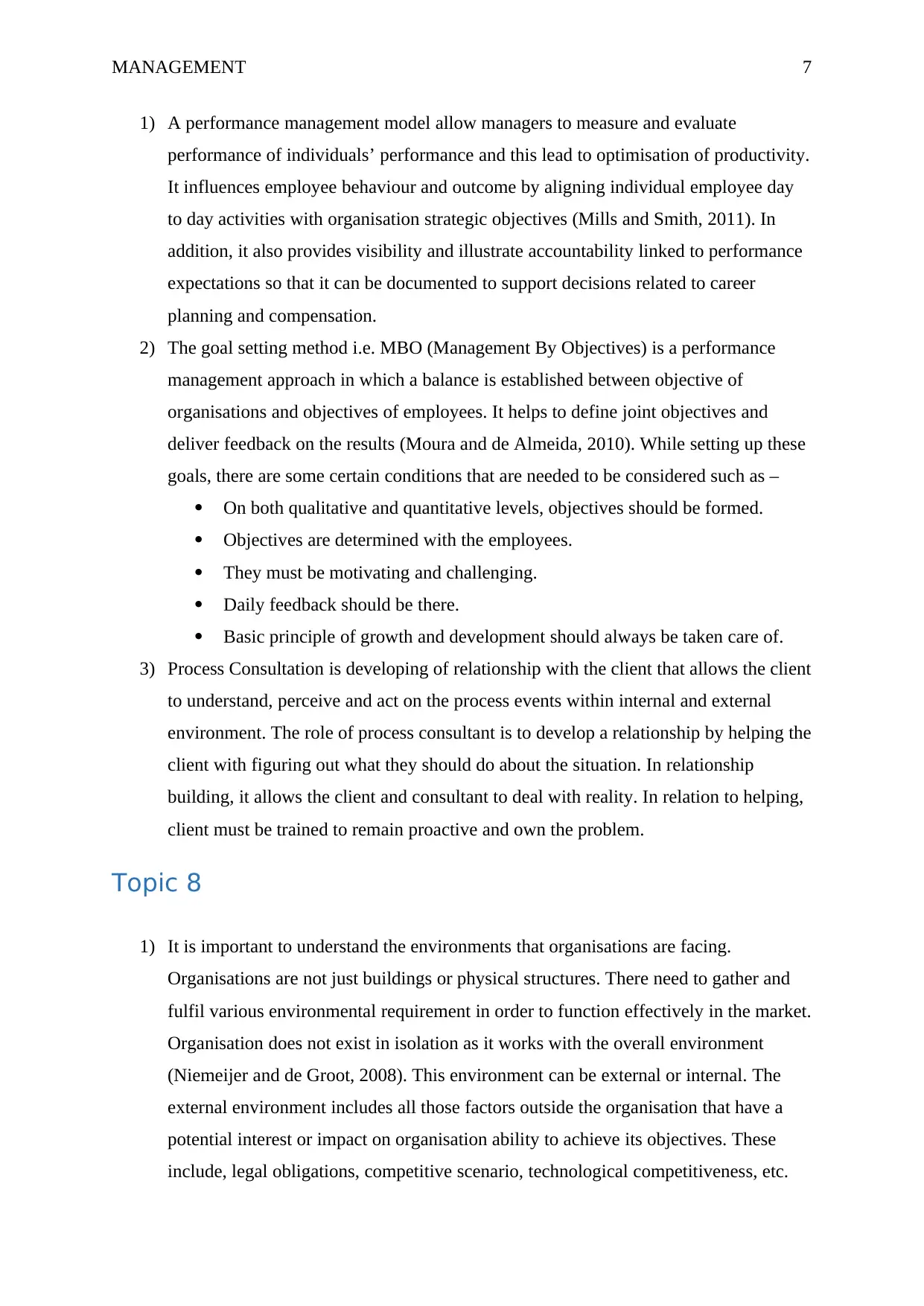
MANAGEMENT 7
1) A performance management model allow managers to measure and evaluate
performance of individuals’ performance and this lead to optimisation of productivity.
It influences employee behaviour and outcome by aligning individual employee day
to day activities with organisation strategic objectives (Mills and Smith, 2011). In
addition, it also provides visibility and illustrate accountability linked to performance
expectations so that it can be documented to support decisions related to career
planning and compensation.
2) The goal setting method i.e. MBO (Management By Objectives) is a performance
management approach in which a balance is established between objective of
organisations and objectives of employees. It helps to define joint objectives and
deliver feedback on the results (Moura and de Almeida, 2010). While setting up these
goals, there are some certain conditions that are needed to be considered such as –
On both qualitative and quantitative levels, objectives should be formed.
Objectives are determined with the employees.
They must be motivating and challenging.
Daily feedback should be there.
Basic principle of growth and development should always be taken care of.
3) Process Consultation is developing of relationship with the client that allows the client
to understand, perceive and act on the process events within internal and external
environment. The role of process consultant is to develop a relationship by helping the
client with figuring out what they should do about the situation. In relationship
building, it allows the client and consultant to deal with reality. In relation to helping,
client must be trained to remain proactive and own the problem.
Topic 8
1) It is important to understand the environments that organisations are facing.
Organisations are not just buildings or physical structures. There need to gather and
fulfil various environmental requirement in order to function effectively in the market.
Organisation does not exist in isolation as it works with the overall environment
(Niemeijer and de Groot, 2008). This environment can be external or internal. The
external environment includes all those factors outside the organisation that have a
potential interest or impact on organisation ability to achieve its objectives. These
include, legal obligations, competitive scenario, technological competitiveness, etc.
1) A performance management model allow managers to measure and evaluate
performance of individuals’ performance and this lead to optimisation of productivity.
It influences employee behaviour and outcome by aligning individual employee day
to day activities with organisation strategic objectives (Mills and Smith, 2011). In
addition, it also provides visibility and illustrate accountability linked to performance
expectations so that it can be documented to support decisions related to career
planning and compensation.
2) The goal setting method i.e. MBO (Management By Objectives) is a performance
management approach in which a balance is established between objective of
organisations and objectives of employees. It helps to define joint objectives and
deliver feedback on the results (Moura and de Almeida, 2010). While setting up these
goals, there are some certain conditions that are needed to be considered such as –
On both qualitative and quantitative levels, objectives should be formed.
Objectives are determined with the employees.
They must be motivating and challenging.
Daily feedback should be there.
Basic principle of growth and development should always be taken care of.
3) Process Consultation is developing of relationship with the client that allows the client
to understand, perceive and act on the process events within internal and external
environment. The role of process consultant is to develop a relationship by helping the
client with figuring out what they should do about the situation. In relationship
building, it allows the client and consultant to deal with reality. In relation to helping,
client must be trained to remain proactive and own the problem.
Topic 8
1) It is important to understand the environments that organisations are facing.
Organisations are not just buildings or physical structures. There need to gather and
fulfil various environmental requirement in order to function effectively in the market.
Organisation does not exist in isolation as it works with the overall environment
(Niemeijer and de Groot, 2008). This environment can be external or internal. The
external environment includes all those factors outside the organisation that have a
potential interest or impact on organisation ability to achieve its objectives. These
include, legal obligations, competitive scenario, technological competitiveness, etc.
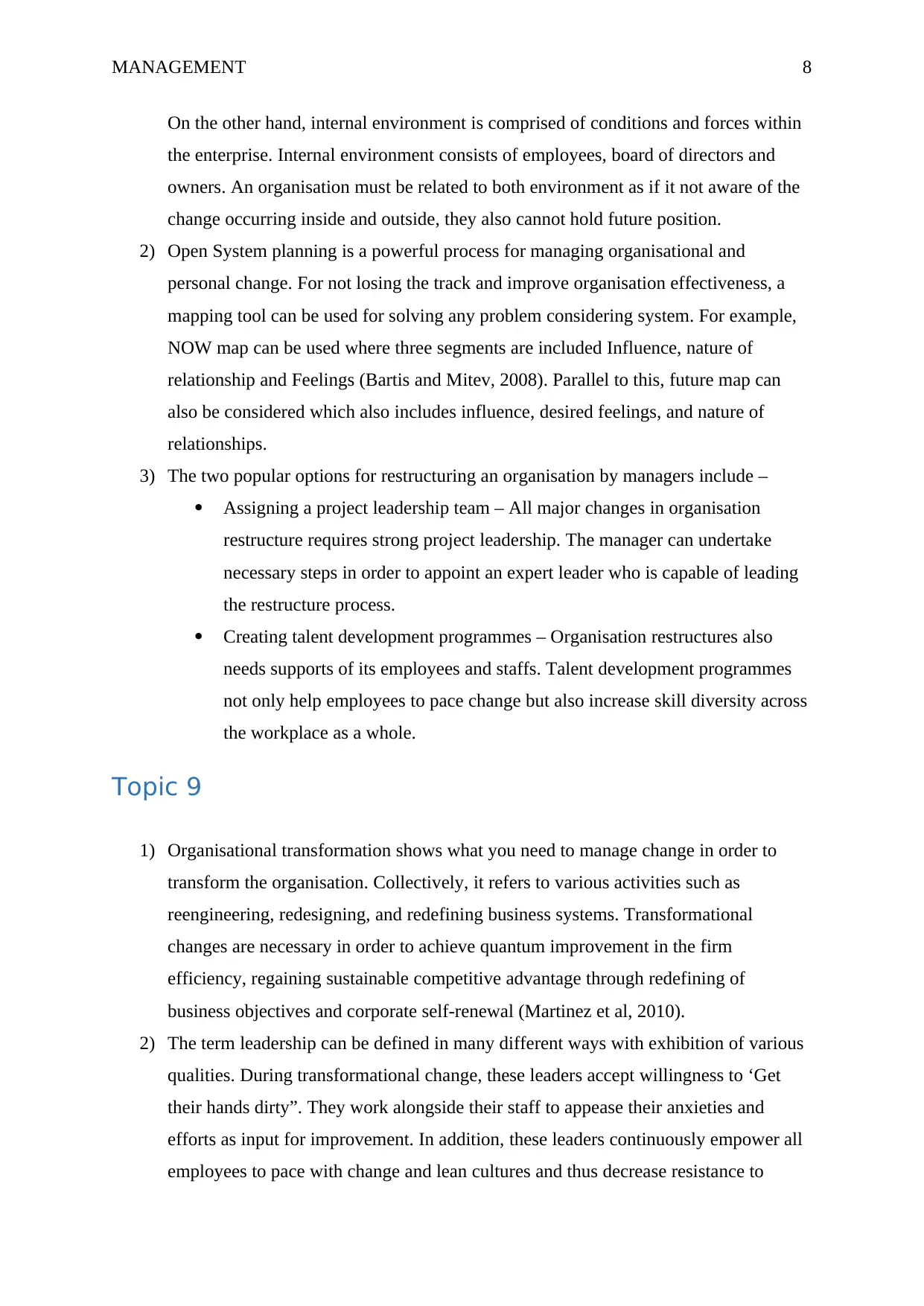
MANAGEMENT 8
On the other hand, internal environment is comprised of conditions and forces within
the enterprise. Internal environment consists of employees, board of directors and
owners. An organisation must be related to both environment as if it not aware of the
change occurring inside and outside, they also cannot hold future position.
2) Open System planning is a powerful process for managing organisational and
personal change. For not losing the track and improve organisation effectiveness, a
mapping tool can be used for solving any problem considering system. For example,
NOW map can be used where three segments are included Influence, nature of
relationship and Feelings (Bartis and Mitev, 2008). Parallel to this, future map can
also be considered which also includes influence, desired feelings, and nature of
relationships.
3) The two popular options for restructuring an organisation by managers include –
Assigning a project leadership team – All major changes in organisation
restructure requires strong project leadership. The manager can undertake
necessary steps in order to appoint an expert leader who is capable of leading
the restructure process.
Creating talent development programmes – Organisation restructures also
needs supports of its employees and staffs. Talent development programmes
not only help employees to pace change but also increase skill diversity across
the workplace as a whole.
Topic 9
1) Organisational transformation shows what you need to manage change in order to
transform the organisation. Collectively, it refers to various activities such as
reengineering, redesigning, and redefining business systems. Transformational
changes are necessary in order to achieve quantum improvement in the firm
efficiency, regaining sustainable competitive advantage through redefining of
business objectives and corporate self-renewal (Martinez et al, 2010).
2) The term leadership can be defined in many different ways with exhibition of various
qualities. During transformational change, these leaders accept willingness to ‘Get
their hands dirty”. They work alongside their staff to appease their anxieties and
efforts as input for improvement. In addition, these leaders continuously empower all
employees to pace with change and lean cultures and thus decrease resistance to
On the other hand, internal environment is comprised of conditions and forces within
the enterprise. Internal environment consists of employees, board of directors and
owners. An organisation must be related to both environment as if it not aware of the
change occurring inside and outside, they also cannot hold future position.
2) Open System planning is a powerful process for managing organisational and
personal change. For not losing the track and improve organisation effectiveness, a
mapping tool can be used for solving any problem considering system. For example,
NOW map can be used where three segments are included Influence, nature of
relationship and Feelings (Bartis and Mitev, 2008). Parallel to this, future map can
also be considered which also includes influence, desired feelings, and nature of
relationships.
3) The two popular options for restructuring an organisation by managers include –
Assigning a project leadership team – All major changes in organisation
restructure requires strong project leadership. The manager can undertake
necessary steps in order to appoint an expert leader who is capable of leading
the restructure process.
Creating talent development programmes – Organisation restructures also
needs supports of its employees and staffs. Talent development programmes
not only help employees to pace change but also increase skill diversity across
the workplace as a whole.
Topic 9
1) Organisational transformation shows what you need to manage change in order to
transform the organisation. Collectively, it refers to various activities such as
reengineering, redesigning, and redefining business systems. Transformational
changes are necessary in order to achieve quantum improvement in the firm
efficiency, regaining sustainable competitive advantage through redefining of
business objectives and corporate self-renewal (Martinez et al, 2010).
2) The term leadership can be defined in many different ways with exhibition of various
qualities. During transformational change, these leaders accept willingness to ‘Get
their hands dirty”. They work alongside their staff to appease their anxieties and
efforts as input for improvement. In addition, these leaders continuously empower all
employees to pace with change and lean cultures and thus decrease resistance to
⊘ This is a preview!⊘
Do you want full access?
Subscribe today to unlock all pages.

Trusted by 1+ million students worldwide
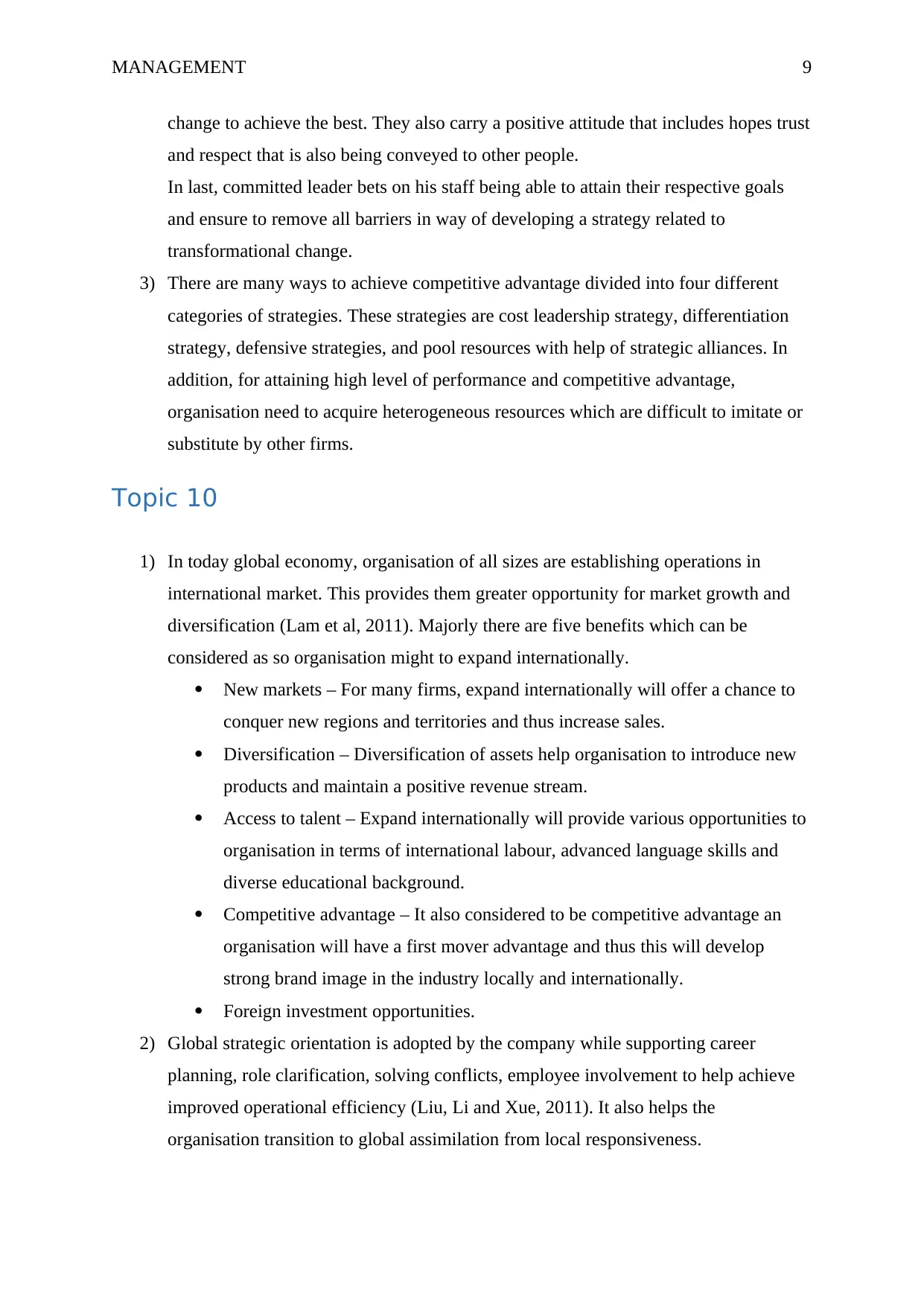
MANAGEMENT 9
change to achieve the best. They also carry a positive attitude that includes hopes trust
and respect that is also being conveyed to other people.
In last, committed leader bets on his staff being able to attain their respective goals
and ensure to remove all barriers in way of developing a strategy related to
transformational change.
3) There are many ways to achieve competitive advantage divided into four different
categories of strategies. These strategies are cost leadership strategy, differentiation
strategy, defensive strategies, and pool resources with help of strategic alliances. In
addition, for attaining high level of performance and competitive advantage,
organisation need to acquire heterogeneous resources which are difficult to imitate or
substitute by other firms.
Topic 10
1) In today global economy, organisation of all sizes are establishing operations in
international market. This provides them greater opportunity for market growth and
diversification (Lam et al, 2011). Majorly there are five benefits which can be
considered as so organisation might to expand internationally.
New markets – For many firms, expand internationally will offer a chance to
conquer new regions and territories and thus increase sales.
Diversification – Diversification of assets help organisation to introduce new
products and maintain a positive revenue stream.
Access to talent – Expand internationally will provide various opportunities to
organisation in terms of international labour, advanced language skills and
diverse educational background.
Competitive advantage – It also considered to be competitive advantage an
organisation will have a first mover advantage and thus this will develop
strong brand image in the industry locally and internationally.
Foreign investment opportunities.
2) Global strategic orientation is adopted by the company while supporting career
planning, role clarification, solving conflicts, employee involvement to help achieve
improved operational efficiency (Liu, Li and Xue, 2011). It also helps the
organisation transition to global assimilation from local responsiveness.
change to achieve the best. They also carry a positive attitude that includes hopes trust
and respect that is also being conveyed to other people.
In last, committed leader bets on his staff being able to attain their respective goals
and ensure to remove all barriers in way of developing a strategy related to
transformational change.
3) There are many ways to achieve competitive advantage divided into four different
categories of strategies. These strategies are cost leadership strategy, differentiation
strategy, defensive strategies, and pool resources with help of strategic alliances. In
addition, for attaining high level of performance and competitive advantage,
organisation need to acquire heterogeneous resources which are difficult to imitate or
substitute by other firms.
Topic 10
1) In today global economy, organisation of all sizes are establishing operations in
international market. This provides them greater opportunity for market growth and
diversification (Lam et al, 2011). Majorly there are five benefits which can be
considered as so organisation might to expand internationally.
New markets – For many firms, expand internationally will offer a chance to
conquer new regions and territories and thus increase sales.
Diversification – Diversification of assets help organisation to introduce new
products and maintain a positive revenue stream.
Access to talent – Expand internationally will provide various opportunities to
organisation in terms of international labour, advanced language skills and
diverse educational background.
Competitive advantage – It also considered to be competitive advantage an
organisation will have a first mover advantage and thus this will develop
strong brand image in the industry locally and internationally.
Foreign investment opportunities.
2) Global strategic orientation is adopted by the company while supporting career
planning, role clarification, solving conflicts, employee involvement to help achieve
improved operational efficiency (Liu, Li and Xue, 2011). It also helps the
organisation transition to global assimilation from local responsiveness.
Paraphrase This Document
Need a fresh take? Get an instant paraphrase of this document with our AI Paraphraser
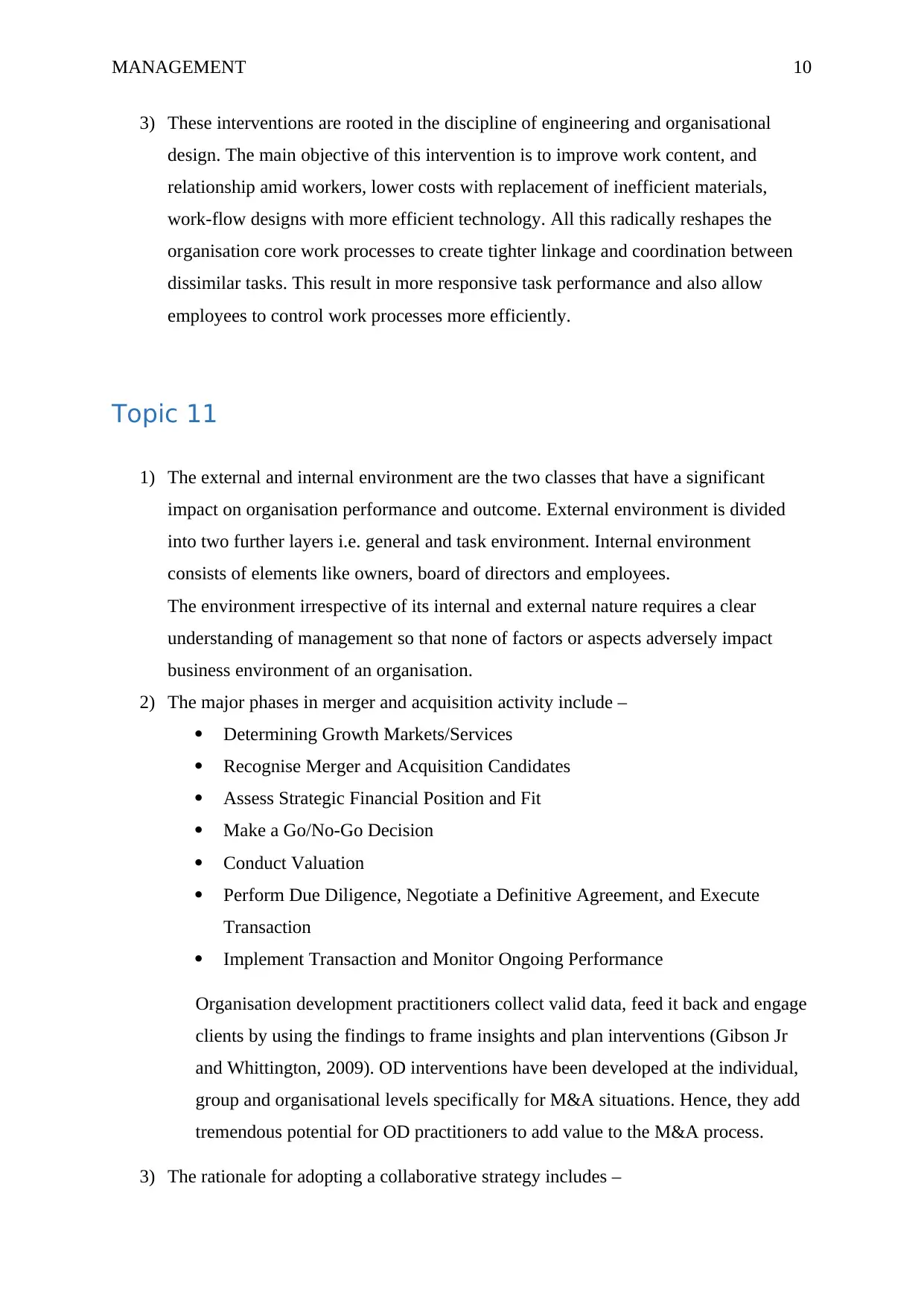
MANAGEMENT 10
3) These interventions are rooted in the discipline of engineering and organisational
design. The main objective of this intervention is to improve work content, and
relationship amid workers, lower costs with replacement of inefficient materials,
work-flow designs with more efficient technology. All this radically reshapes the
organisation core work processes to create tighter linkage and coordination between
dissimilar tasks. This result in more responsive task performance and also allow
employees to control work processes more efficiently.
Topic 11
1) The external and internal environment are the two classes that have a significant
impact on organisation performance and outcome. External environment is divided
into two further layers i.e. general and task environment. Internal environment
consists of elements like owners, board of directors and employees.
The environment irrespective of its internal and external nature requires a clear
understanding of management so that none of factors or aspects adversely impact
business environment of an organisation.
2) The major phases in merger and acquisition activity include –
Determining Growth Markets/Services
Recognise Merger and Acquisition Candidates
Assess Strategic Financial Position and Fit
Make a Go/No-Go Decision
Conduct Valuation
Perform Due Diligence, Negotiate a Definitive Agreement, and Execute
Transaction
Implement Transaction and Monitor Ongoing Performance
Organisation development practitioners collect valid data, feed it back and engage
clients by using the findings to frame insights and plan interventions (Gibson Jr
and Whittington, 2009). OD interventions have been developed at the individual,
group and organisational levels specifically for M&A situations. Hence, they add
tremendous potential for OD practitioners to add value to the M&A process.
3) The rationale for adopting a collaborative strategy includes –
3) These interventions are rooted in the discipline of engineering and organisational
design. The main objective of this intervention is to improve work content, and
relationship amid workers, lower costs with replacement of inefficient materials,
work-flow designs with more efficient technology. All this radically reshapes the
organisation core work processes to create tighter linkage and coordination between
dissimilar tasks. This result in more responsive task performance and also allow
employees to control work processes more efficiently.
Topic 11
1) The external and internal environment are the two classes that have a significant
impact on organisation performance and outcome. External environment is divided
into two further layers i.e. general and task environment. Internal environment
consists of elements like owners, board of directors and employees.
The environment irrespective of its internal and external nature requires a clear
understanding of management so that none of factors or aspects adversely impact
business environment of an organisation.
2) The major phases in merger and acquisition activity include –
Determining Growth Markets/Services
Recognise Merger and Acquisition Candidates
Assess Strategic Financial Position and Fit
Make a Go/No-Go Decision
Conduct Valuation
Perform Due Diligence, Negotiate a Definitive Agreement, and Execute
Transaction
Implement Transaction and Monitor Ongoing Performance
Organisation development practitioners collect valid data, feed it back and engage
clients by using the findings to frame insights and plan interventions (Gibson Jr
and Whittington, 2009). OD interventions have been developed at the individual,
group and organisational levels specifically for M&A situations. Hence, they add
tremendous potential for OD practitioners to add value to the M&A process.
3) The rationale for adopting a collaborative strategy includes –
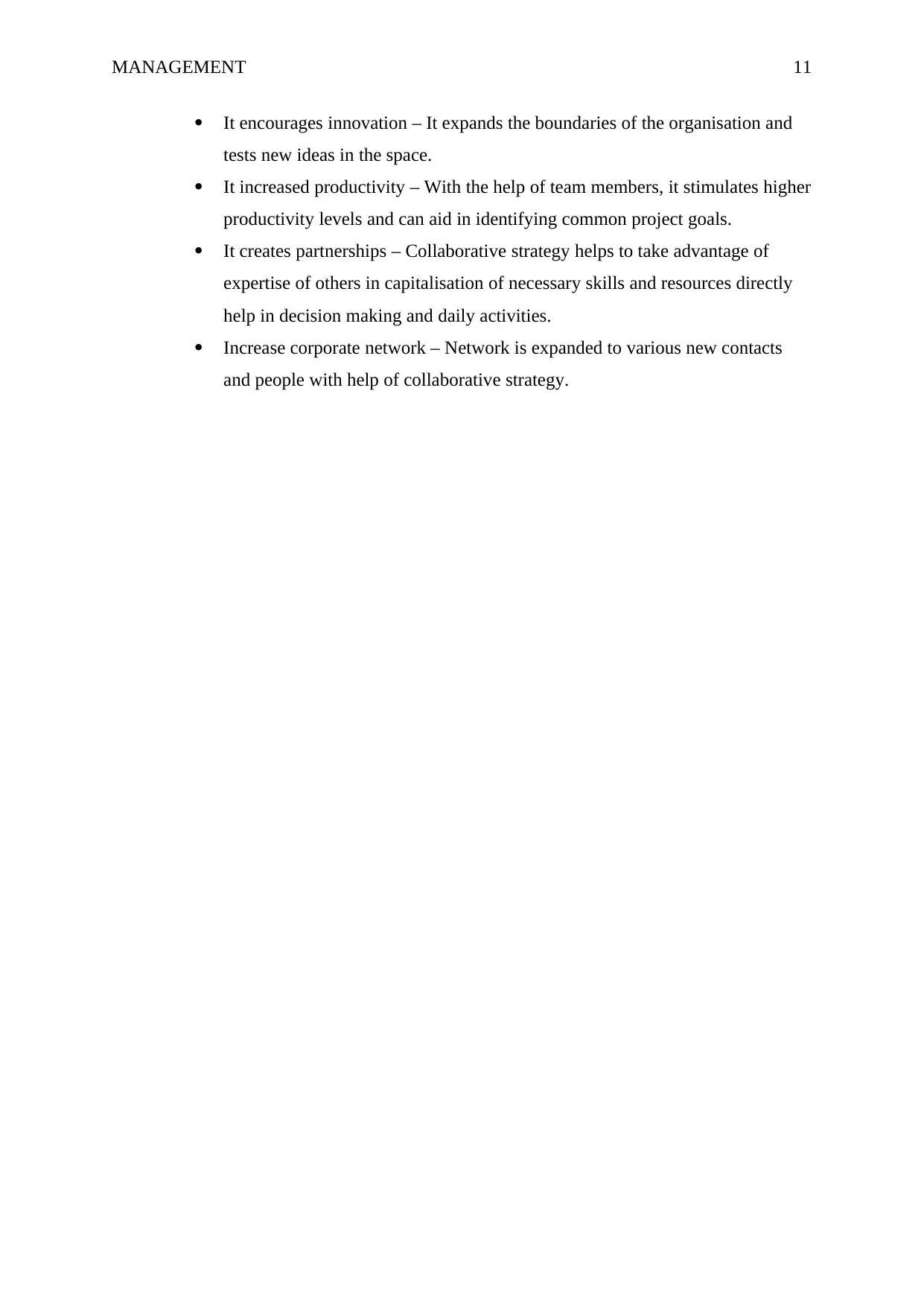
MANAGEMENT 11
It encourages innovation – It expands the boundaries of the organisation and
tests new ideas in the space.
It increased productivity – With the help of team members, it stimulates higher
productivity levels and can aid in identifying common project goals.
It creates partnerships – Collaborative strategy helps to take advantage of
expertise of others in capitalisation of necessary skills and resources directly
help in decision making and daily activities.
Increase corporate network – Network is expanded to various new contacts
and people with help of collaborative strategy.
It encourages innovation – It expands the boundaries of the organisation and
tests new ideas in the space.
It increased productivity – With the help of team members, it stimulates higher
productivity levels and can aid in identifying common project goals.
It creates partnerships – Collaborative strategy helps to take advantage of
expertise of others in capitalisation of necessary skills and resources directly
help in decision making and daily activities.
Increase corporate network – Network is expanded to various new contacts
and people with help of collaborative strategy.
⊘ This is a preview!⊘
Do you want full access?
Subscribe today to unlock all pages.

Trusted by 1+ million students worldwide
1 out of 15
Related Documents
Your All-in-One AI-Powered Toolkit for Academic Success.
+13062052269
info@desklib.com
Available 24*7 on WhatsApp / Email
![[object Object]](/_next/static/media/star-bottom.7253800d.svg)
Unlock your academic potential
Copyright © 2020–2025 A2Z Services. All Rights Reserved. Developed and managed by ZUCOL.





